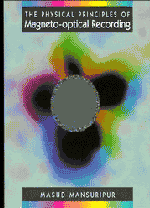Book contents
- Frontmatter
- Contents
- Preface
- 1 Overview of Optical Data Storage
- 2 Optics of Gaussian Beams
- 3 Theory of Diffraction
- 4 Diffraction of Gaussian Beams from Sharp Edges
- 5 Optics of Thin Films and Multilayers
- 6 Magneto-optical Readout
- 7 Effects of High-numerical-aperture Focusing on the State of Polarization
- 8 Computer Modeling of the Optical Path
- 9 Noise in Magneto-optical Readout
- 10 Modulation Coding and Error Correction
- 11 Thermal Aspects of Magneto-optical Recording
- 12 Fundamentals of Magnetism and Magnetic Materials
- 13 Magnetostatics of Thin-film Magneto-optical Media
- 14 Mean-field Analysis of Amorphous Rare Earth–Transition Metal Alloys
- 15 Magnetization Dynamics
- 16 Origins of Coercivity
- 17 The Process of Thermomagnetic Recording
- 18 Media Characterization
- References
- Index
10 - Modulation Coding and Error Correction
Published online by Cambridge University Press: 07 September 2010
- Frontmatter
- Contents
- Preface
- 1 Overview of Optical Data Storage
- 2 Optics of Gaussian Beams
- 3 Theory of Diffraction
- 4 Diffraction of Gaussian Beams from Sharp Edges
- 5 Optics of Thin Films and Multilayers
- 6 Magneto-optical Readout
- 7 Effects of High-numerical-aperture Focusing on the State of Polarization
- 8 Computer Modeling of the Optical Path
- 9 Noise in Magneto-optical Readout
- 10 Modulation Coding and Error Correction
- 11 Thermal Aspects of Magneto-optical Recording
- 12 Fundamentals of Magnetism and Magnetic Materials
- 13 Magnetostatics of Thin-film Magneto-optical Media
- 14 Mean-field Analysis of Amorphous Rare Earth–Transition Metal Alloys
- 15 Magnetization Dynamics
- 16 Origins of Coercivity
- 17 The Process of Thermomagnetic Recording
- 18 Media Characterization
- References
- Index
Summary
Introduction
In a digital system, the so-called “user-data” is typically an unconstrained sequence of binary digits 0 and 1. In such devices it is the responsibility of the information storage subsystem to record the data and to reproduce it faithfully and reliably upon request. To achieve high densities and fast data rates, storage systems are usually pushed to the limit at which the strength of the readout signal is of the same order of magnitude as that of the noise. Operating under these circumstances, it should come as no surprise that errors of misinterpretation do indeed occur at the time of retrieval. Also, because individual bits are recorded on microscopic areas, the presence of small media imperfections and defects, dust particles, fingerprints, scratches, and the like, results in imperfect reconstruction of the recorded binary sequences. For these and other reasons to be described below, the stream of user-data typically undergoes an encoding process before it finally arrives on the storage medium. The encoding not only adds some measure of protection against noise and other sources of error, but also introduces certain useful features in the recorded bit-pattern that help in signal processing and future data recovery operations. These features might be designed to allow the generation of a clocking signal from the readout waveform, or to maintain the balance of charge in the electronic circuitry, or to enable more efficient packing of data on the storage medium, or to provide some degree of control over the spectral content of the recorded waveform, and so on.
- Type
- Chapter
- Information
- The Physical Principles of Magneto-optical Recording , pp. 329 - 349Publisher: Cambridge University PressPrint publication year: 1995



